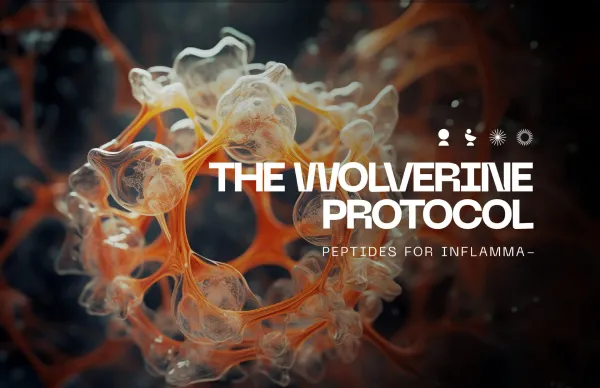Blog
No More Tylenol or Advil: Treat Inflammation More Naturally With the BPC157 and TB500 Wolverine Protocol

Contents
What are BPC157 and TB500?
How does the BPC157 Wolverine protocol work?
How does the TB500 Wolverine protocol work?
The benefits of the Wolverine protocol
Potential side effects and risks of BPC157 and TB500
Dosage and administration
Is the Wolverine protocol legal?
Wolverine protocol verdict
The Wolverine protocol incorporates the use of peptides like BPC157 and TB500. Although the research on these amino acids is limited, anecdotal studies look promising.
Advocates claim these compounds facilitate rapid healing and soothe inflammation. They reportedly also offer a host of other benefits. Could peptides be the solution you’re looking for?
Keep reading to uncover more about the Wolverine protocol. We delve deeper into the world of TB500 and BPC157 peptides, their advantages, and their risks.
What are BPC157 and TB500?
TB500 and BPC157 are synthetic peptides that could treat various conditions. They’re made up of a specific number of amino acid chains.
BPC157 stands for Body Protection Compound. The number refers to its amino acid composition. It’s derived from a protein in gastric juice. This peptide is small and consists of 15 amino acids. It occurs naturally in your body, but scientists can also synthesize it.
TB500 is a synthetic form of a healing protein. It replicates thymosin beta, which is released by the thymus gland. This peptide’s functions are diverse, and it could boost immune health.
The BPC157 and TB500 blend attracts the attention of numerous health enthusiasts. Some people refer to these peptides as the Wolverine protocol. The properties of these compounds may be the next step in healing various conditions.
How does the BPC157 Wolverine protocol work?
BPC157 has various mechanisms of action, and some overlap. This peptide occurs naturally in the gastric juice of the stomach in the human body. It helps with intestinal tract repairs. The digestive system gets put under intense pressure, so accelerated healing is essential.
One of the BPC157 benefits is it reportedly keeps the host of organs in this region running smoothly. It may also regenerate intestine wall cells. It could reduce the risk of ulcers and contribute to several other mechanisms of action. The peptide may also boost gut health.
BPC157 interacts with the nitric oxide pathway. This impacts key growth factors and blood vessels. As a result, this peptide may encourage more energy and oxygen flow to injuries. The compound could also stimulate angiogenic cytokines.
It has a role in boosting the anti-inflammatory gene transcription factor. BPC157 is involved with growth hormone receptors. It reportedly facilitates the development and spread of fibroblasts and other regenerative and systemic repair responses.
Studies on peptide therapy in the form of the Wolverine protocol are anecdotal. Researchers have conducted most of the testing on rodents. Although the evidence is limited, available research demonstrates positive results for accelerated healing.
How does the TB500 Wolverine protocol work?
One of the functions of TB500 is to regulate actin and myosin. These key proteins are involved in cell structure and movement. The peptide binds to the actin monomers, forming polymers, and ultimately actin filaments.
This action has a catalyst effect that promotes cell proliferation and migration. TB500 reportedly facilitates the movement of these cells to sites of injury. It also delegates fibroblasts and other reparative cells to accelerate wound repair.
The peptide plays a critical role in angiogenesis. It may help with the formation of new blood vessels, which in turn aids with inflammation.
TB500 has a unique molecular structure. It doesn’t bind to the extracellular matrix. This property allows it to travel extended distances in the body. This is why TB500 benefits occur in local and distant injury sites.
Advocates of the Wolverine protocol claim it assists with wound healing and inflammation in various parts of the body, including:
- Skin
- Brain
- Bones
- Heart
In its natural form, the peptide gets released from platelets in the body. It then helps with various immune functionalities at a cellular level.
TB500 stimulates T-cell production, which positively affects the immune system. It also increases B-cells, which create antibodies and further boost the immune response.
The benefits of the Wolverine protocol
BPC157 and TB500 each offer unique properties. Some advantages of the compounds overlap, making the blend quite powerful. Let’s take a look at each peptide’s functions and reported benefits.
BPC157 benefits
The role of this peptide in the body is clear, but how does it help in synthetic form? We already highlighted that it could accelerate healing, but it may also contribute to the longevity and regeneration of cells.
Damaged cells display an increased healing rate when exposed to BPC157. Health enthusiasts, fitness buffs, and people with ailments all have an interest in it. The potential of BPC157 benefits is vast.
Advocates of the compound assert it facilitates healing at a rapid pace. The accelerated regeneration is where the nickname “Wolverine protocol” comes from. It hints at a Marvel comic book character who heals quickly.
The BPC157 peptide’s benefits include:
- Improving gut health
- Soothing and reducing inflammation
- Easing stomach ulcers
- Accelerating wound healing
- Boosting cellular regeneration
- Helping with bone and joint repair
- Assisting with organ healing
- Promoting muscular (angiogenesis) growth
- Positively impacting neurotransmitters
TB500 benefits
There are multiple reported applications of TB500 in the body. Advocates for the peptide assert it expedites recovery and reduces inflammation swiftly.
Some people who have arthritis find it therapeutic due to the anti-inflammatory properties. TB500 reportedly accelerates recovery and improves mobility. This is most evident in joints.
Anecdotal evidence suggests TB500 may also be effective in treating blood clots. It’s said to heal soft tissue damage rapidly. Your ligaments and tendons stand to benefit most from the peptide.
Other reported TB500 benefits include:
- Treating certain chronic problems and autoimmune conditions. Studies suggest it could help with Lyme disease and brain injuries.
- Helping with muscle function and recovery. Anecdotal research suggests the peptide assists with muscle spasms, too.
- Aiding with cardiovascular conditions. TB500 purportedly promotes cardiac cell survival after injury.
- Promoting new blood vessels and neuron formation via its angiogenesis properties.
When TB500 and BPC157 combine, the impact on the body is even more pronounced. They complement each other in the recovery process. When blended, their roles in wound healing and tissue creation improve.
Together, they promote angiogenesis and cytoprotection. TB500 influences the recovery of tissue, bones, and ligaments. BPC157 offers a higher level of anti-inflammatory properties. The latter’s neuroprotective and cardioprotective qualities are also more evident.
Potential side effects and risks of BPC157 and TB500
Medication sometimes causes side effects. Peptides like BPC157 and TB500 are no different. While the advantages outweigh the risks, it’s best to be aware of them.
The most commonly reported side effect of BPC157 is pain and inflammation. These occur at the site of the injection. Other common reactions are:
- Cold or hot flashes
- Changes in appetite
- Dizziness or drowsiness
- Headaches
- Fatigue
Consult a medical practitioner if the side effects exceed a week. There’s a consensus that peptides are harmful to fetuses, so avoid using them during pregnancy. BPC157 doesn’t interact well with many peptides. Consult a professional before trying different combinations.
TB500 has mild side effects that include:
- Flushed face
- Headaches
- Dizziness
- Drowsiness
- Lethargy
- Flu-like symptoms
TB500 may have a negative impact on individuals with certain autoimmune diseases. Conditions with possible contraindications include psoriasis, rheumatoid arthritis, and Hashimoto’s disease (chronic lymphocytic thyroiditis).
Dosage and administration
There are several ways to administer BPC157 and TB500.
The most popular method is to inject peptides subcutaneously. You can also consume them orally or opt for an intramuscular injection.
These methods are typically associated with BPC157. TB500 is typically delivered the same way. You also have the option of capsules, nasal sprays, and topical products.
BPC157 delivery
BPC157 acts systemically. To administer a subcutaneous injection, pinch an area of skin and inject the needle. It might be easier if you angle it. Be sure to clean the area with an alcohol swab first.
The same hygiene rules apply to intramuscular injections. This technique is slightly more challenging. You need to insert the needle through the skin and into the muscle. Ensure you do this as close to the site as possible.
Once you inject the peptide, massage the area with your hands for about a minute. Some advocates believe this facilitates absorption.
Oral application is straightforward. Once you spray it in your mouth, hold it there for approximately two minutes. The peptide is also available as a nasal spray.
When it comes to dosage, it’s best to consult an expert. Subcutaneous injections typically amount to around 200 micrograms (mcg). Application occurs over a cycle of 25 days.
TB500 delivery
With TB500, intramuscular and subcutaneous injections are the most popular. There are also capsules and nasal sprays for easier application.
While there are no clear guidelines for human consumption, experimental quantities range from 2–5 mg administered twice a week. The duration of these trials is less than eight weeks.
Reconstituting BPC157 and TB500
BPC157 and TB500 come in powder form and need reconstituting for injections. Combine each peptide with bacteriostatic water in the correct ratios.
Use a syringe when inserting the bacteriostatic water. Aim the liquid at the sides of the bottle rather than directly at the powder. Be fragile with the fluid and keep it away from UV rays.
At room temperature, it should remain stable for approximately ten weeks. It typically lasts up to six months in the fridge. Freezer storage keeps it stable for roughly two years.
Is the Wolverine protocol legal?
BPC157 and TB500 aren’t approved for human use by the Food and Drug Administration (FDA). These amino acid chains are only legally available for research. As such, online sellers currently retail it for this purpose only.
The peptides have active bans by several anti-doping agencies. Athletes who test positive for the Wolverine protocol may face disciplinary action.
Wolverine protocol verdict
The combination of BPC157 and TB500 displays promising results. Although research is limited, the available studies look positive. Despite legal roadblocks, many people advocate for the Wolverine protocol.
Now that you know more about TB500 and BPC157, you might feel intrigued to try these peptides. Why not check out our LIVV Anti-Inflammatory product blend? It contains all you need to initiate the Wolverine protocol.
Author: Dr. Jason Phan NMD – Founder of LIVV Natural – Anti-aging – regenerative medicine – peptide therapy


